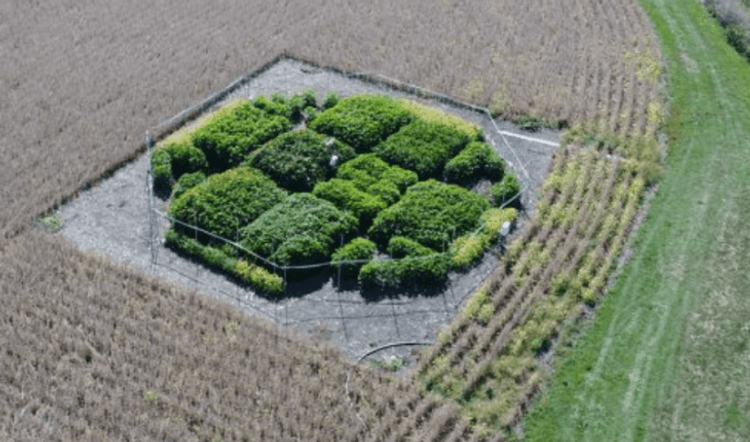
Photosynthesis uses the enzyme Rubisco—the planet’s most abundant protein—and sunlight energy to turn carbon dioxide and water into sugars that fuel plant growth and yield. Over millennia, Rubisco has become a victim of its own success, creating an oxygen-rich atmosphere. Unable to reliably distinguish between the two molecules, Rubisco grabs oxygen instead of carbon dioxide about 20 percent of the time, resulting in a plant-toxic compound that must be recycled through the process of photorespiration.
“Photorespiration is anti-photosynthesis,” said lead author Paul South, a research molecular biologist with the Agricultural Research Service, who works on the RIPE project at Illinois. “It costs the plant precious energy and resources that it could have invested in photosynthesis to produce more growth and yield.”
Photorespiration normally takes a complicated route through three compartments in the plant cell. Scientists engineered alternate pathways to reroute the process, drastically shortening the trip and saving enough resources to boost plant growth by 40 percent. This is the first time that an engineered photorespiration fix has been tested in real-world agronomic conditions.
Fixing photosynthetic inefficiencies
In some of our most useful crops (such as rice and wheat), photosynthesis produces toxic by-products that reduce its efficiency. Photorespiration deals with these by-products, converting them into metabolically useful components, but at the cost of energy lost. South et al. constructed a metabolic pathway in transgenic tobacco plants that more efficiently recaptures the unproductive by-products of photosynthesis with less energy lost. In field trials, these transgenic tobacco plants were ∼40% more productive than wild-type tobacco plants.
Structured Abstract
Meeting food demands for the growing global human population requires improving crop productivity, and large gains are possible through enhancing photosynthetic efficiency. Photosynthesis requires the carboxylation of ribulose-1,5-bisphosphate (RuBP) by ribulose-1,5-bisphosphate carboxylase-oxygenase (RuBisCO), but photorespiration occurs in most plants such as soybean, rice, and wheat (known as C3 crops) when RuBisCO oxygenates RuBP instead, requiring costly processing of toxic byproducts such as glycolate. Photorespiration can reduce C3 crop photosynthetic efficiency by 20 to 50%. Although various strategies exist for lowering the costs of photorespiration, chamber- and greenhouse-grown plants with altered photorespiratory pathways within the chloroplast have shown promising results, including increased photosynthetic rates and plant size.
Reason
To determine if alternative photorespiratory pathways could effectively improve C3 field crop productivity, we tested the performance of three alternative photorespiratory pathways in field-grown tobacco. One pathway used five genes from the Escherichia coli glycolate oxidation pathway; a second pathway used glycolate oxidase and malate synthase from plants and catalase from E. coli; and the third pathway used plant malate synthase and a green algal glycolate dehydrogenase. All enzymes in the alternative pathway designs were directed to the chloroplast. RNA interference (RNAi) was also used to down-regulate a native chloroplast glycolate transporter in the photorespiratory pathway, thereby limiting metabolite flux through the native pathway. The three pathways were introduced with and without the transporter RNAi construct into tobacco, which is an ideal model field crop because it is easily transformed, has a short life cycle, produces large quantities of seed, and develops a robust canopy similar to that of other field crops.
Results
Using a synthetic biology approach to vary promoter gene combinations, we generated a total of 17 construct designs of the three pathways with and without the transporter RNAi construct. Initial screens for photoprotection by alternative pathway function under high–photorespiratory stress conditions identified three to five independent transformants of each design for further analysis. Gene and protein expression analyses confirmed expression of the introduced genes and suppression of the native transporter in RNAi plants. In greenhouse screens, pathway 1 increased biomass by nearly 13%. Pathway 2 showed no benefit compared to wild type. Introduction of pathway 3 increased biomass by 18% without RNAi and 24% with RNAi, which were consistent with changes in photorespiratory metabolism and higher photosynthetic rates. Ultimately, field testing across two different growing seasons showed >25% increase in biomass of pathway 3 plants compared to wild type, and with RNAi productivity increased by >40%. In addition, this pathway increased the light-use efficiency of photosynthesis by 17% in the field.
Conclusion
Engineering more efficient photorespiratory pathways into tobacco while inhibiting the native pathway markedly increased both photosynthetic efficiency and vegetative biomass. We are optimistic that similar gains may be achieved and translated into increased yield in C3 grain crops because photorespiration is common to all C3 plants and higher photosynthetic rates under elevated CO2, which suppresses photorespiration and increases harvestable yield in C3 crops.
